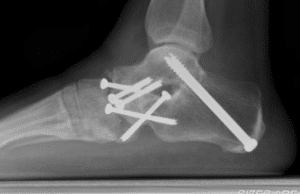Total Ankle Replacement

Total ankle replacement has come a long way since its beginnings and is a common surgical procedure, often also known as also total ankle arthroplasty. This procedure is usually done by foot and ankle orthopedic surgeons to treat ankle arthritis, injury, or both.
In this surgery, the ankle joint is removed and replaced with an artificial implant. Total ankle replacement surgery should provide pain relief while preserving or improving the overall ankle movement.
What is the History of Total Ankle Replacement?
According to this study, total ankle replacement surgery was first attempted in the early 1970s. When the attempts began, poor beginning results led to an abandonment of the practice in favor of ankle arthrodesis, otherwise known as ankle fusion. First and second-generation ankle prosthetic designs presented limited function and constraint issues, causing them to be either too unstable or too restrictive.
These designs were made by Lord and Marotte and were a simple ball and socket type of implant. In this attempt, they carried out 25 replacement surgeries and reviewed them after an average of 5.6 years. After this amount of time, they found that only 7 cases could be considered as satisfactory. These designs led to dislocation, implant loosening, and occasionally also led to catastrophic failure.
They also often required the removal of significant amounts of the distal tibia and talus bone, which cause progressive bone loss, difficult revision situations, and premature collapse of the soft bone. Because of these results, many continued to practice ankle fusion instead.
What is Ankle Fusion?
Ankle fusion, instead of replacing the ankle joint, fuses together two or more bones of your ankle into one piece. However, ankle fusion or arthrodesis is not always a satisfactory surgery and often causes further hindfoot arthritis. These complications led back to the practice and the resurgence of the studying of total ankle replacement.
Advances in Ankle Replacement?
It was new designs that more closely approximated the natural anatomy of the ankle that brought forth better results. These designs also often used biomechanics to get better results. It was only very recently that there was a significant uptick in total ankle arthroplasty. The newer third and fourth-generation models have corrected many of the previous issues due to their use of ankle biomechanics, concomitant ipsilateral foot pathology work, and better design and implant technique. Now, ankle replacement surgery does better in improving ankle arthritis, and overall movement.
While total ankle replacement has been improved very much over the past decades, it is still one of the least common joints to be completely replaced. This is because ankles aren’t as commonly affected by primary osteoarthritis. In over 70% of ankle osteoarthritis cases, the osteoarthritis was caused by “abnormalities in ankle formation or result from trauma, most commonly associated with ankle fractures and/or recurrent ankle instability.” This means that far fewer ankle replacement surgeries are done than other joint replacement surgeries, and far fewer surgeons specialize in it as a result.
Technology and Advances in Ankle Replacement
At the moment there are about twenty different ankle replacements available on the marketplace worldwide, and all of them consist of three components. These components are: the Salto™ (Tornier, Grenoble, Hintegra® (Integra, France), Ankle Evolution System (AES) (Biomet Europe, Belgium), Bologna-Oxford (BOX) (Finsbury, Leatherhead, UK), France) and Mobility (Depuy, Leeds, UK).
There are also many different total ankle arthroplasty systems that are currently being used for this surgery. The five different systems used in the United States are INBONE (Wright Medical Group), INFINITY (Wright Medical Group), Salto Talaris (Integra Lifesciences), Scandinavian Total Ankle Replacement (STAR [Stryker]), and Trabecular Metal Total Ankle (Zimmer Biomet). The two newest systems that have recently entered the US market: the VANTAGE (Exactech) and the Cadence (Integra LifeSciences). Let’s look at each of these systems.
- INBONE by Wright Medical Group uses sulcus design, talar fixation, comprehensive sizing, and refined instrumentation in their surgery method. The INBONE™ Total Ankle System was created in 2005 and was the first total ankle system that provided intramedullary instrumentation. Some features of INBONE are that it allows physicians to customize it based on each patient’s needs, it uses Long anchoring stems that are available in varying sizes to best match the patient’s anatomy.
- INFINITY by Wright Medical Group uses a low-Profile tibial implant design, resurfacing talar component designed for full fluoroscopic visualization, is optimized for the best efficiency and accuracy possible and has talar component interchangeability. Some features of INFINITY are that it increases initial stability through greater friction, uses a low-profile tibial implant design, and has a resurfacing talar component that is designed for full fluoroscopic visualization.
- Salto Talaris by Integra Lifesciences is a “semi-constrained prosthesis consisting of two mating components: a metal tibial tray in association with an insert and one of two metal talar dome options; a chamfer-cut resurfacing talar dome implant or a flat-cut talar dome implant.” The Salto Talaris cuts less bone than other competitor systems, it has been found that has better or similar results to mobile-bearing ankle arthroplasty, has seen less cyst formation than competitor systems, and has high survivorship rates.
- Scandinavian Total Ankle Replacement (STAR™ Ankle) by Stryker has a mobile bearing, unlike other competitor systems, which allows more joint movement, instead of being fixed in place. It also does not require the use of bone cement to hold the replacement in its position. Studies have shown superior effectiveness and comparable safety results with the use of STAR. The system contains a talar component, tibial plate, and a mobile bearing made from a medical-grade plastic called polyethylene.
- Trabecular Metal Total Ankle by Zimmer Biomet features a “low profile design, lateral surgical approach, and industry-first Prolong® Highly Crosslinked Polyethylene.” Some of its features include a prolonged highly crosslinked polyethylene bearing surface to reduce volumetric wear, the use of trabecular metal that has a high coefficient of friction, a reduced amount of cut bone.
- VANTAGE by Exactech combined engineering and surgeon expertise to create a new total ankle replacement system. VANTAGE comes in curved and flat cut talus and tibia components, that are used based on the patient’s needs. The curved design allows for less bone to be cut, and a tighter fixation and stability.
- Cadence by Integra LifeSciences was designed for large amounts of efficiency and optimal fit. It uses fluoroscopic cues for implant alignment, has faster operating time, has 672 implant combinations, and has biased poly options.
Things to Know Before Ankle Surgery
Before you consider total ankle replacement you’ve likely explored other less invasive options with your doctor. Preliminary actions include non-surgical treatments like anti-inflammatory medication, bracing, physical therapy, activity modification, and corticosteroid or other injections. If these have not worked, your doctor then may suggest total or partial ankle replacement. You may need total ankle replacement surgery if you have osteoarthritis, rheumatoid arthritis, or common arthritis.
It has been found that arthritis in the ankle is often caused by damages to the ankle through severe injury. Though, it has also been found that arthritis can be caused by many minor injuries that have happened to your ankle over time, like fractures, sprains, and the twisting of the ankle.
Before deciding that you want to move forward with total ankle replacement surgery, you might want to learn about the risks and complications involved with this surgery. While total ankle replacement has been found to be extremely successful in most cases, there are still risks that come with any surgery, this one included. Here are some of the main risks:
- Infection
- Blood clot
- Damage to nearby nerves
- Bleeding
- The bones not joining together properly
- Misalignment of the bones
- New arthritis in neighboring joints
- Loosening of the artificial components, which might eventually need a follow-up surgery
- Wearing out of the components
- A broken bone on the side of the total ankle implant is one of the most common complications
- Issues with wound healing can lead to superficial or deep infections
It is important to note that the range of these complications are based on your age and previous medical conditions you may have. Greater complications may occur if you smoke, have diabetes (especially poorly controlled diabetes), or have rheumatoid arthritis. Some complications may not happen until years after your surgery and may require additional surgeries or procedures.
Before you agree to have surgery, you should meet with your doctor to sit down and discuss the risks and complications that may affect you, based on many aspects like your preexisting conditions, age, and other concerns you may have.
Preparing for Ankle Surgery
Before surgery, you should talk with your doctor about how to prepare. This may include stopping certain medications, stopping smoking, or monitoring your health to make sure you don’t have any recent fevers before your surgery. You may also want to take additional imaging tests, like X-rays, CT scans, or MRIs. You’ll also want to adjust your living arrangements for the weeks after the operation, because you will need to be using crutches, and may need additional assistance like help with driving.
Many total replacement surgeries are different depending on the systems your doctor is using, so make sure to talk with your doctor in detail about what to expect. Here are some things that are relatively universal:
- General anesthesia or nerve block to put you to sleep or to block out pain during the surgery so you are not in any pain or discomfort
- An incision through the skin and muscle
- The damaged portions of your shinbone and talus may be removed
- A tourniquet to control bleeding and improve visualization during the surgery
- New metal and plastic joint surfaces placed into the pieces of your remaining bones
- Your doctor may use a special type of cement to hold the metal joint surfaces in place
- The layers of skin and muscle around your ankle and foot will be surgically closed with stitches or staples
- A splint will be applied
Post-Surgery Recovery
After your surgery is completed, your medical team should continue to monitor you carefully as you recover. After you wake up, your leg will be lifted and immobilized. Recovery will require you to wear a cast or boot to allow the implants to heal in place and to keep you in a non-weight-bearing state. Strict elevation for days after the surgery is also very necessary, and you may need to stay in the hospital for a few nights to do this. Immediately after your surgery, you need follow-up X-rays to see how the surgery went.
There also may be in a significant amount of pain, so your doctor may put you on pain medications to manage this. The pain should go away after a few days, and eventually you should be in less pain than you were prior to your surgery as you start to heal. When your doctor advises, you’ll be doing post-surgery physical therapy.
Post-Surgery Physical Therapy
Your doctor may suggest that you start physical therapy for a few months after your operation. This will help you regain your strength and range of motion. If your X-Rays come back good, you may be able to participate in weight-bearing activities sooner than later. Always make sure you are following your doctor’s orders for rehabilitation, the medications you should be taking, wound care. By doing this, you will have better chances of a positive outcome.
Integrated Orthopedics offers total ankle replacement surgery with Dr. Nilin Rao, fellowship trained foot and ankle surgeon. Dr. Rao is specifically trained in total ankle replacement surgery. He will discuss all options available with you during your consultation so you can rest assured you’ll be on the correct path based on your specific condition, anatomy, and situation.
It is very important that you talk to a specialist before making your choice to have total ankle replacement surgery. Schedule a consultation with Dr. Rao today to go over your options, your past medical history, his specific surgery methods, potential risks for you, and – most important – a plan to address your ankle pain!




